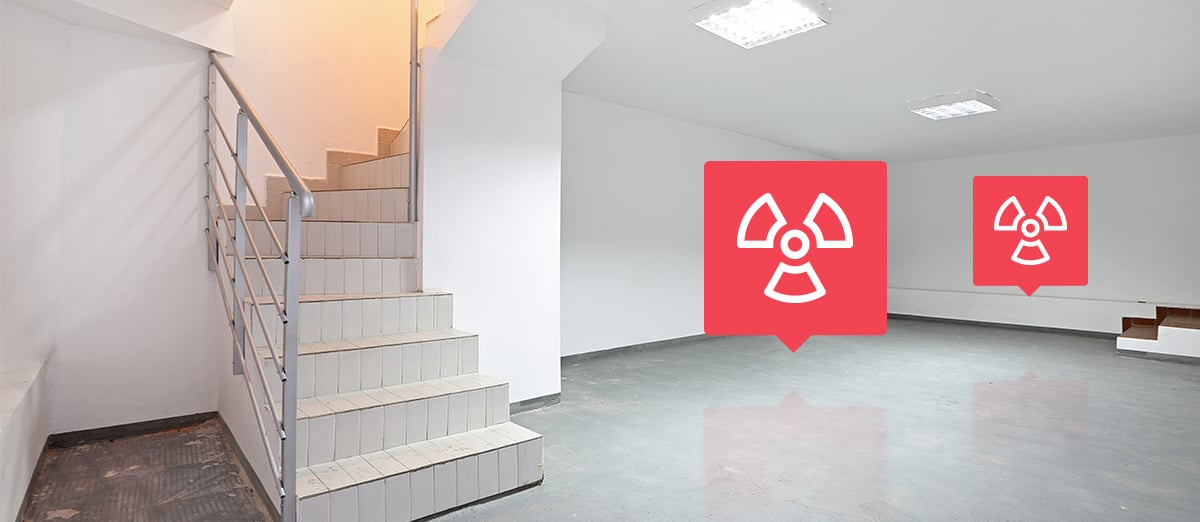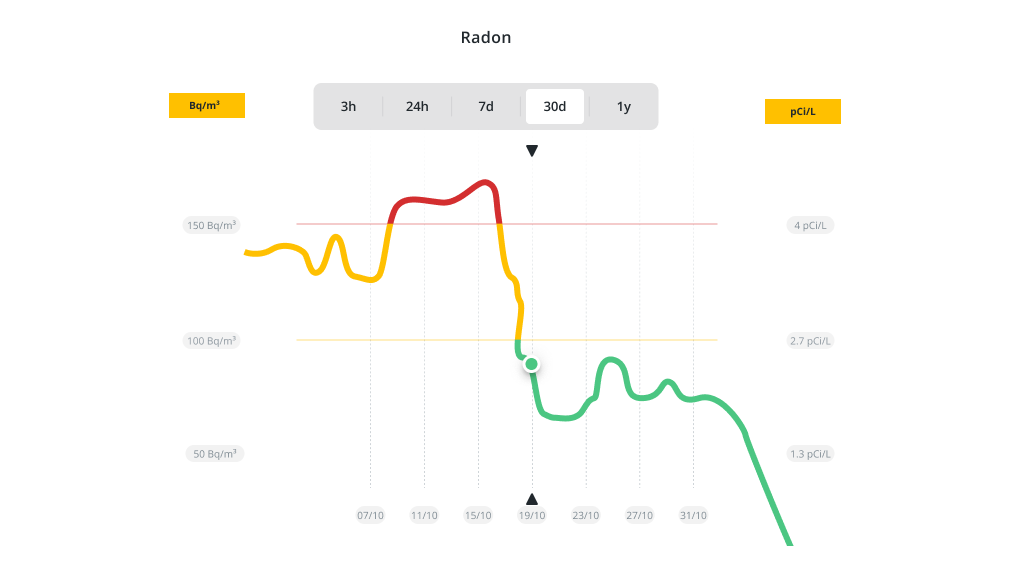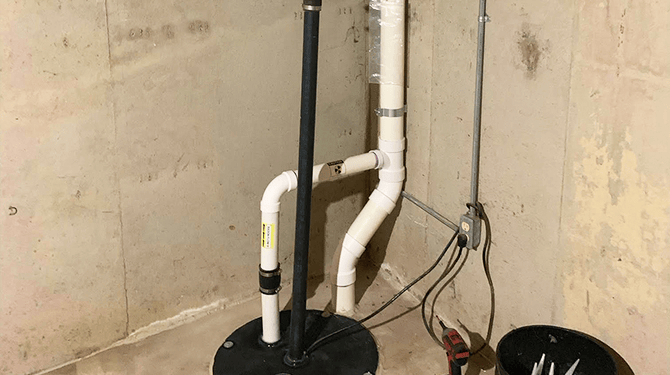2. Assess the age of your home
Knowing how old your home is will help you plan the DIY radon mitigation system installation. If the home was built before the 1970s, the fill used beneath your cement slab foundation is probably not ideal. An ideal fill is porous, meaning it lets gas breathe. This would allow you to pull out the air relatively easily. A non-ideal fill is dense, either very wet earth or rock. These require more effort as you need to figure out how to suck the air through this dense earth and out through your system.
3. Analyze your home's structure
Before you run pipe through your foundation, home, and roof, you should analyze your home’s design structure for a couple of key details.
First, additions. If sections of your home were added on after the initial construction, you may need to mitigate radon from multiple areas of your home. This would be the case if your foundation slab is not fully continuous, meaning there are pockets of air beneath your home each of which would require different mitigation systems, complicating the DIY radon mitigation system installation.
Second, current drainage systems. Do you have a French drain or a drain tile inside the house that you can use to draw radon up out of? If so, you may not need to drill through the foundation slab.
Third, soil composition. You may be able to call your home’s builder to find out what type of fill was used beneath your foundation slab. If not, you can drill a hole and check. You want a gravel-like fill because it promotes airflow. Wet sand or earth allows much less airflow. If you have a wet earth situation, you will need to put your arm into the hole you drill in the foundation and dig out a foot or two in each direction. This should allow the pipe, situated well above the bottom of the pit, to pull up an adequate amount of air.
Last, current foundation compromises. Check where pipes go through the foundation to make sure they are fully sealed and plug up cracks, even hairline cracks, in the slab. These efforts will make the slab airtight, allowing the system to get a good level of suction.
4. Planning the pipe
You’ll want to use PVC pipe from three (3) to four (4) inches in diameter [available at Home Depot and Lowe's]. This means you’re going to need to drill three to four (3–4) inch holes in different levels of your home. Again, there are couple specific details to consider about your particular home.
First, you will want to avoid running the pipe through your living areas as it looks bad. So, is there a path you can take that avoids frequented areas? Common solutions include running it up from the basement into an attached garage and out the garage’s roof, or else through a closet inside the home. You do want to keep the PVC running inside the home to reduce condensation and limit exposure to the elements – this helps the system last longer.
Second, the pipe needs to come out of your roof at a point that is at least ten (10) feet away from any windows on a horizontal plane. This is because the pipe expels radon gas, and if it’s too near a window it can come back into your house through a window.
The pipe, which is often several different pieces of pipe fitted together with necessary elbow or other joints and PVC cement, must also extend one (1) foot above the roof’s surface.
You will need sandpaper and a hacksaw (or equivalent) to section the piping and debur it (which is necessary to keep a tight seal).
5. Fan placement
You will need to place the fan such that it is outside the living area of your house: in the attic, in the garage, or outside (least preferred). This is required of a radon mitigation system, as it protects you from a leak at the site of the fan, which would result in a pooling of radon as the fan pulls radon up but then fails to expel it from the home. This is why it’s also essential to constantly monitor the radon level if you have a mitigation system installed. The intake/outtake hole size of your radon mitigation fan will dictate the size of the PVC pipe you should buy.
6. Drilling holes
Find a good location in your foundation to drill. An ideal spot is near a wall where you can bracket the PVC piping to.
Once you are ready to drill, measure a hole slightly larger than your PVC diameter. Using a jackhammer, drill through the foundation until you hit the fill below. Depending on the density of this fill, you may need to drill additional aeration to allow for proper ventilation area. This may be aided by a roto driller to help create the initial ground space beneath your foundation hole.
You will need to use a handsaw or a wide-diameter drill to get through the various walls, floors, and roofs involved in running the pipe from the foundation to the roof.
7. Laying pipe
Run the pipe from your roof to your basement floor. Start with the roof line and make sure the entire piping system is sealed and bracketed in place from the roof to the basement. As part of this process, you will need to attach the fan to the piping structure, ideally in an attic-like space. If the piping does run through a space that might be a different temperature than the rest of the house (attics and garages), you will need to insulate the piping to reduce condensation. Put the final pipe in the hole you’ve drilled in the foundation and seal it into the system. You’re now ready to make the system airtight.
8. Sealing holes
You’re going to want to caulk and hydraulic cement to seal the roof and foundation respectively. You should also have some backer rods to fill the space between the PVC pipe and the foundation hole before applying hydraulic cement to the seam.
9. Testing the system
Finally, you need to make sure your system mitigates radon. To do this, turn on the fan and, with a small hole at another point in the foundation (drilled for testing purposes) use a smoking piece of burning paper to see if air is being sucked into that hole. This tells you the system is up and running, sucking air from across the foundation to the site of the mitigation piping. Finally, install a manometer on the basement piping, which will tell you whether or not the system is creating the pressure differential necessary to suck air up from the ground.
Keep investigating your radon levels with the use of Airthings devices and ensure your radon reduction system is working, with proper equipment and action in place actually helping you mitigate radon.
Summary
There is a lot to think about in undertaking a DIY mitigation installation. With a bit of preparation and research, you can do the job yourself. However, there are several certified radon mitigation professionals capable of doing the job who are moderately affordable, considering the extent of the job.
And after the installation of your own radon mitigation system, it’s important to keep testing for radon. You wouldn’t want to stop checking test radon levels, trust the system, and then fail to notice a system malfunction. Therefore, a long-term radon detector is a good investment to your radon mitigation system.
FAQ
How do I get rid of radon?
Here are some ways to mitigate radon at home: increase ventilation, seal cracks, install a radon reduction system, hire a certified mitigator, and test your home. Remember to always test your home again after mitigation work.
How long does it take to air out high radon areas?
The time it takes to air out high radon areas depends on factors such as the type of test used, the home's size, and the mitigation system installed. Short-term tests provide a snapshot of radon levels in a few days, while long-term tests take months. Standard radon reduction systems are effective within 24 hours, and testing after installation ensures levels fall below the threshold.
What are signs of radon in your house?
Radon is a colorless, odorless, and tasteless gas that can be present in homes, schools, and offices. It is a radioactive gas that is produced from the breakdown of uranium in soil and rocks. Radon can enter buildings through cracks in floors or walls, construction joints, or gaps in foundations around pipes, wires, or pumps. The gas is usually concentrated in the basement or crawl space of a building. Testing with certified radon monitors is the only way to know if radon is present in your home.
Can I install a radon system myself?
Installing a radon system yourself is possible, but it requires specific knowledge, skills, and equipment. If you're confident in your skills and knowledge, and you're comfortable with the installation steps, you can consider installing a radon system yourself. However, if any part of the process makes you uncomfortable, it's best to hire a professional to ensure the job is done correctly and to avoid potential health risks and additional expenses
What is the fastest way to get rid of radon?
Radon removal time varies depending on factors. Radon testing should be consistent and it might be longer then you expect. However, There are proven methods to reduce radon in your home, such as vent pipe systems, sealing cracks, and using HRV/ERV machines. For best results and peace of mind, it is important to hire a certified mitigator and test your home regularly.














